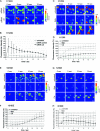CHRNA5 as negative regulator of nicotine signaling in normal and cancer bronchial cells: effects on motility, migration and p63 expression
- PMID: 21586512
- PMCID: PMC3165122
- DOI: 10.1093/carcin/bgr090
CHRNA5 as negative regulator of nicotine signaling in normal and cancer bronchial cells: effects on motility, migration and p63 expression
Abstract
Genome-wide association studies have linked lung cancer risk with a region of chromosome 15q25.1 containing CHRNA3, CHRNA5 and CHRNB4 encoding α3, α5 and β4 subunits of nicotinic acetylcholine receptors (nAChR), respectively. One of the strongest associations was observed for a non-silent single-nucleotide polymorphism at codon 398 in CHRNA5. Here, we have used pharmacological (antagonists) or genetic (RNA interference) interventions to modulate the activity of CHRNA5 in non-transformed bronchial cells and in lung cancer cell lines. In both cell types, silencing CHRNA5 or inhibiting receptors containing nAChR α5 with α-conotoxin MII exerted a nicotine-like effect, with increased motility and invasiveness in vitro and increasing calcium influx. The effects on motility were enhanced by addition of nicotine but blocked by inhibiting CHRNA7, which encodes the homopentameric receptor α7 subunit. Silencing CHRNA5 also decreased the expression of cell adhesion molecules P120 and ZO-1 in lung cancer cells as well as the expression of DeltaNp63α in squamous cell carcinoma cell lines. These results demonstrate a role for CHRNA5 in modulating adhesion and motility in bronchial cells, as well as in regulating p63, a potential oncogene in squamous cell carcinoma.
Figures





References
Publication types
MeSH terms
Substances
LinkOut - more resources
Full Text Sources
Medical
Research Materials
Miscellaneous

